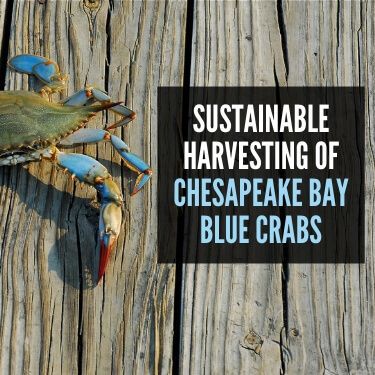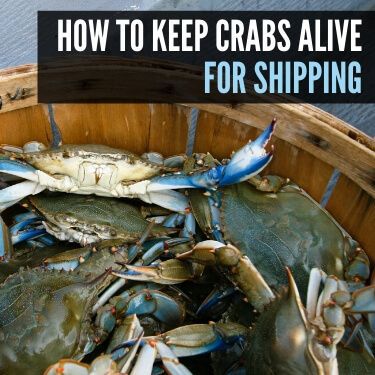For fans of seafood, there might not be much better than some blue crab. For suppliers and their shippers, there might not be much more exacting than successfully transporting blue crabs that are still living. It has to be done a very certain way or there’s a very real risk of the meat being unappetizing or crabs dying in transit and not being able to be cooked.
In order to transport blue crabs, shippers must ensure that the temperature is kept at 50 degrees Fahrenheit, the crabs stay moist or in water, and moved in a stress-free environment. If shipped frozen, it's crucial that the meat is properly insulated and kept in a temperature-controlled environment.
Read more below to learn more about the blue crab and the best practices for shipping them safely.

Here’s the good news — since hitting a low point in 2014, the population of blue crabs in the Chesapeake Bay has rebounded to about 594 million. Roughly 10 percent of the crabs in the bay are harvested each year, which makes the blue crab a sustainable seafood.
Fisheries in Maryland and Virginia have used science-based guidelines for combating overfishing. For blue crabs, in particular, that has been important as the bay grasses they need to lay eggs and hide from predators are still on the road to recovery. Improving the overall water quality of Chesapeake Bay is not only a goal to help humans but also sea life like the blue crab.
The Food and Drug Administration (FDA) mandates that facilities that process and ship out seafood products undergo mandatory inspections periodically.
However, the FDA does not regulate the shipping of the seafood outside of basic sanitary practices and it is instead on the shipper and the shipper to make sure the packaged seafood is kept safe for consumption.

If you’re shipping blue crabs alive and they die, they cannot be consumed. First of all, the meat will turn mushy and not be as appetizing. Second, the bacteria that grow inside a dead crab’s shell are not good for human consumption and could make someone eating it very ill.
To help blue crabs stay alive and thrive, their environment must meet three crucial conditions — cool temperature, moistness, and free of stress. We will break down each of these aspects and why each is important.
Temperature: The optimal temperature to ship blue crabs is 50 degrees Fahrenheit. This keeps the crabs cool and in a state of lethargy so they can make the trip easier. Warmer than 50 degrees and they might be frisky in their containers; colder than 50 degrees runs the risk of killing the crabs. To meet this temperature, keep crabs in a cooler lined at the bottom with gel packs or dry ice at the bottom. So the crabs don’t get too cold, you might want to add a layer, like a towel or something that can withstand dampness. Commercial fishermen use a burlap sack but that might not be conducive to shipping.
Moistness: Crabs have gills and need to be in water to fully thrive and survive. However, if they are kept cool and moist, they can live out of water for up to 24 hours. The way to accomplish this while the crab is in transit is to use a towel or some kind of cloth that is soaked with water. However, keep the crabs away from standing water too, as this will also kill them.
Free of stress: All three of these steps are imperative but this is one that needs a level of care taken. Stress will kill a blue crab and there are some precautions you can take so they don’t suffer an undue amount that would lead to that loss.
If you follow these steps, the blue crabs should get to their destination ready to be prepared for hungry diners.
There's a demand for Chesapeake Bay crab in the Lone Star State. Learn about freight shipping from Maryland to Texas and satisfy the demanding seafood market.
Crab meat — and seafood in general — is best transported using cold packs in insulated boxes or containers to help keep the orders frozen. Containers should be well-sealed and labeled properly. If you’re shipping whole crabs, they will need to be wrapped individually in a protective manner because shells can crack rather easily during transport.
But since frozen crab meat can be stored for months as opposed to just a couple of days for fresh, there isn’t the same rush and an expedited form of shipping isn’t necessary.
For more tips on how to ship crab and seafood that's already been frozen, check out our article on shipping frozen seafood.
Depending on if the blue crab is raw or cooked, and also set in the refrigerator or freezer, there are various lengths they can be kept for.
First off, if the meat in question is out on the counter at room temperature and is raw, it needs to be either refrigerated or frozen as soon as possible. If the crab is cooked, it can be left out for no more than 2 hours before it will be unfit to eat. In a refrigerated state, raw or cooked crab can last about 2 to 3 days without an issue.
In a frozen state, crab meat can be stored for up to 3 months, but it needs to be thoroughly cleaned first. You can also freeze a whole blue crab before cooking it. In fact, it is best to freeze the crab still in the shell because the shell will help prevent the meat from losing its tenderness.
Once you’re ready for transporting blue crab from Chesapeake Bay, let R+L Global Logistics make it a stress-free experience for you (and the crabs).
With our 99.5 percent on-time rate and real-time freight visibility, you’ll know where your crabs are at any given moment in the shipping process and also have the confidence that they will arrive there still at their freshness peak. We also offer comprehensive customer service for our freight services when you ship with us.
Most seafood shipment is made within 24 hours, which is something R+L Global Logistics and its partners are well-equipped to handle. So if you’re ready to ship your blue crab catches to all places where fans of seafood reside or need to ship furniture by the truckload, get a free freight quote on our website or call us at (866) 353-7178.
R+L Global Logistics
315 NE 14th St., Ocala, FL 34470